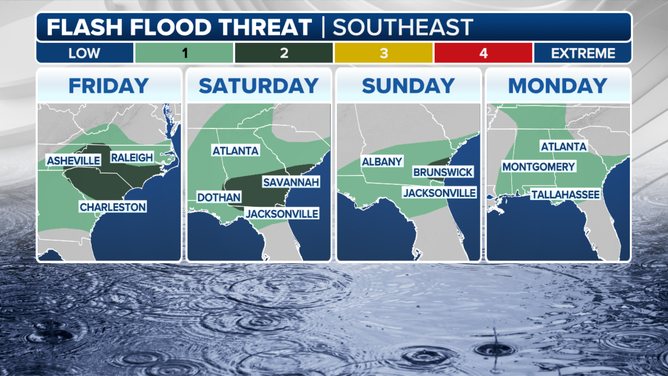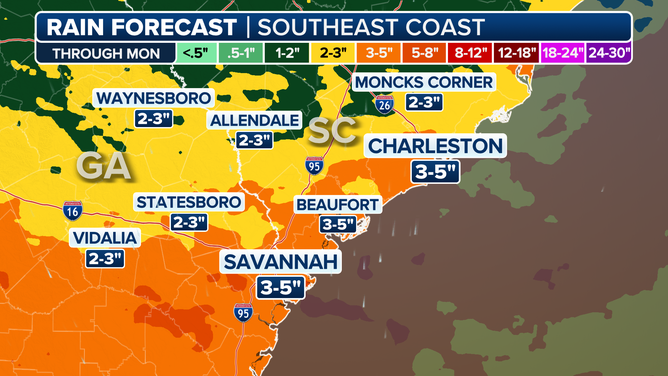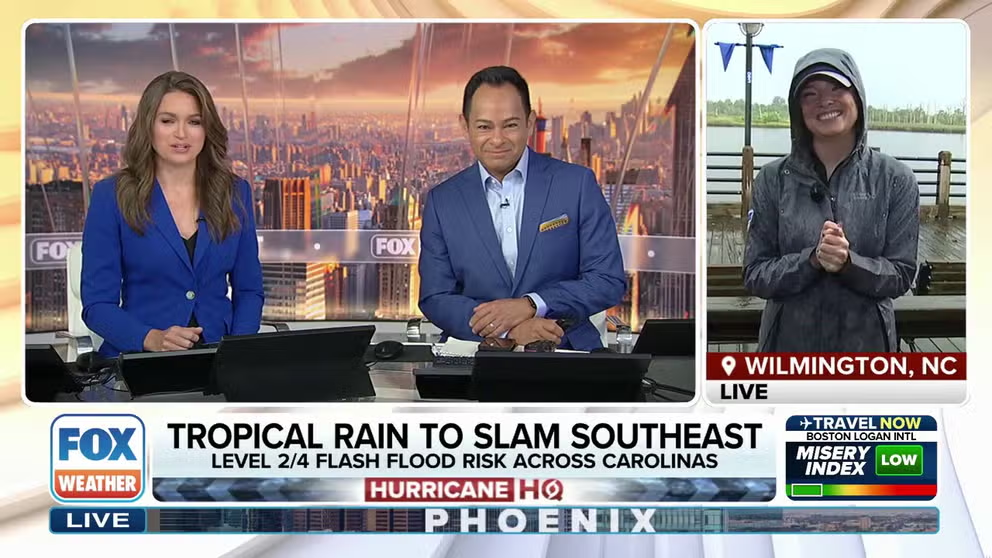Flash flooding threat returns to Southeast as powerful front brings days of heavy rains
A powerful cold front that brought deadly flooding to the mid-Atlantic and Northeast is sliding south into the Southeast over the weekend, where it will become essentially parked into next week.
Tropical rain begins to soak Carolinas, bringing flash flood risk
The first round of tropical downpours have begun in parts of the Carolinas. NOAA's Weather Prediction Center has issued a Level 2 out of 4 flash flood risk for parts of the Carolinas, with heavy rain also expected in Georgia. FOX Weather Meteorologist Bayne Froney has the latest from Wilmington, North Carolina.
WILMINGTON, N.C. -- Another days-long stretch of soggy weather is plaguing the Southeast, raising fears of flash flooding and washing out another precious summer weekend along its popular beaches.
A powerful cold front that brought deadly flooding to the mid-Atlantic and Northeast is sliding south into the Southeast over the weekend, where it will become essentially parked into next week.
Heavy rains soak Wilmington as front stalls across Southeast
Soaking rains ruined beach day along the North Carolina coast as a flash flood threat persists into the weekend.
There is even a low chance of the front spawning some tropical development in the Atlantic, or along the Southeast coast or even back toward the Gulf Coast, depending on favorable atmospheric conditions.

Southeast Tropical Chances
(FOX Weather)
"It's a boundary over warm sea-surface temperatures," FOX Weather Meteorologist Ian Oliver said. "If it hangs around too long, it's going to have a chance at developing at least some tropical characteristics."
However, the chances of tropical development remain low.

(FOX Weather)
Regardless, the front has tapped into plenty of tropically-infused moisture, and heavy downpours are expected across the Southeast.
The action will kick off with a bang later Friday as a potent cold front charges across the Carolinas. Numerous thunderstorms will develop along the front, bringing the threat of flash flooding all across the Carolinas.
Rainfall totals could reach 2–3 inches in many areas, with isolated amounts of 3-5 inches possible, according to the FOX Forecast Center.

Southeast Rain Forecast
(FOX Weather)
NOAA's Weather Prediction Center has placed a swath of the Carolinas at a level 2 out of 4 flash flood risk through Friday, shifting to coastal Georgia and South Carolina on Saturday.

Flash Flood Threat Through Monday
The coastal Carolinas and the mountains of western North and South Carolina have the greatest risk of getting more than 3 inches within a 6-hour period. That includes cities like Charleston, South Carolina; Savannah, Georgia; and Charlotte and Wilmington, North Carolina.

Savannah-Charleston Rain Forecast
(FOX Weather)
FOX Weather Meteorologist Bayne Froney noted that ponding had already started near her location in Wilmington Friday morning after just 20 minutes of rain.
"We could see pretty intense rain rates at time," said Froney. "Even if (a) storm doesn't last too long, it could really drop a lot of rain at a time, so it's really important to take these flash flood warnings seriously."
On Saturday and Sunday, the cold front and its attendant storms will continue to sink south and east, according to the FOX Forecast Center. While the morning should be rather quiet, storms will quickly develop during the afternoon in an arc around the edge of the cold front.
This setup will see the low country of South Carolina, southern Georgia, and most of Alabama see the bulk of the storm action. NOAA's Weather Prediction Center shifts the level 2 out of 4 flood risk into Georgia, including Savannah, Valdosta, and Albany, plus Jacksonville, Florida. Up to 5 inches of rain with locally higher amounts up to 7 inches could fall in this corridor through Sunday alone, the FOX Forecast Center says.
Rain could linger for more than a week
As the new week begins, the forecast will remain very much the same: wet. An upper-level disturbance is forecast to slide back into the region from the east and stall across the Deep South, not only maintaining a feed of moisture, but energizing storms that do form.
The stubborn pattern will lead to 7–10 days of scattered thunderstorms dousing the Southeast, particularly Georgia and the western Carolinas.
Rainfall amounts are still uncertain, but there will be some continued risk of flooding that may increase as the week progresses and the rain totals pile up.
Flooding driven by tropical downpours has been a common theme in the weather pattern for the Southeast over the past month. Chantal made landfall on the South Carolina coast in early July, and two other tropical disturbances have moved across the Southeast since then.

